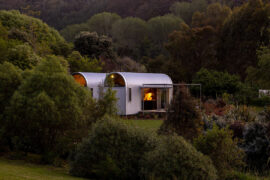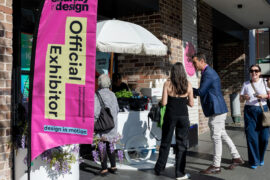Arguably Thailand’s most famous architect, Duangrit Bunnag discusses The Creative District – a new vision for Bangkok’s riverfront – and the importance of conversation.

Duangrit Bunnag
July 11th, 2017
I arrive half an hour early for my meeting with Duangrit Bunnag, at his riverside offices in a restored warehouse complex he has dubbed The Jam Factory. So I make my way to the onsite Library Cafe, filled with designer types sipping on ice lattes and hunched over their MacBook Airs. As I do, I pass by a meeting room lined by a floor-to-ceiling window, where Bunnag – recognisable by his signature circular glasses – is charing a meeting in his capacity as Director of Duangrit Bunnag Architects Limited (DBALP).
“Here we expose our ideas,” smiles Bunnag, as we start our interview shortly after. “We have nothing to hide,” he adds. He’s stood at the other side of a long table with his plans for his latest project, Warehouse 30, unfurled before him. “I was fascinated by these old structures,” he comments, about the seven World War Two-era warehouses he has leased on the other side of the river from where we’re sitting. “So I bid first, and then started to think about what I should do with it!”
Having now put his plans to paper, he envisages one large connected space filled with everything from an organic shop to a screening room to a bicycle hotel – a multi-functional area with a creative buzz akin to Shepherd’s Market in London.
The term ‘creative’ pops up frequently in our discussion, which is to be expected given his role as Director of the newly formed Creative District Foundation. “We started to create a conversation about the ‘Creative District’ around two years ago,” says Bunnag. He continues, “Changes were happening, and there was a need to create an identity of what it was.”
However, he doesn’t see his role as dictating a direction, more as facilitating it. “Controlling is the last thing I want to do. There are no plans and no specifics. The purpose of the Foundation is to be a body that can provide support – after all sponsors need to send money somewhere – but I see the District as something that can be created without authority. “What is missing today is listening and thinking creatively; that is the way we can make new possibilities,” he says.
When Indesignlive.sg last interviewed Bunnag in 2012, the architect’s offices were on the 28th floor of a downtown skyscraper. I ask him if a change in location has led to a different outlook. He responds, “My life has changed a lot. Working in the centre of Bangkok there was high density and an elevated viewpoint. Now, on the ground, I see things differently. It’s softened the way I design, and I’m more connected with people. For instance, the weekend markets we regularly hold here give me the opportunity to talk with real people, and this has changed my attitude to designing a project. It’s now about them, not me.”
He offers a visually stylish simile: “It’s like dancing with a partner. Sure, you can dance by yourself, but everyone’s looking at you. Now there’s more harmony, and designs are more embraced by the client.” One feels though, Bunnag probably still dances to his own tune.
Photography by Wilson Tungthunya
INDESIGN is on instagram
Follow @indesignlive
A searchable and comprehensive guide for specifying leading products and their suppliers
Keep up to date with the latest and greatest from our industry BFF's!

A longstanding partnership turns a historic city into a hub for emerging talent

The undeniable thread connecting Herman Miller and Knoll’s design legacies across the decades now finds its profound physical embodiment at MillerKnoll’s new Design Yard Archives.

London-based design duo Raw Edges have joined forces with Established & Sons and Tongue & Groove to introduce Wall to Wall – a hand-stained, “living collection” that transforms parquet flooring into a canvas of colour, pattern, and possibility.

For Aidan Mawhinney, the secret ingredient to Living Edge’s success “comes down to people, product and place.” As the brand celebrates a significant 25-year milestone, it’s that commitment to authentic, sustainable design – and the people behind it all – that continues to anchor its legacy.

With the inaugural Glenn Murcutt Symposium set to take place in Sydney in September 2025, Pritzker Prize-winner Francis Kéré receives the Murcutt Pin.

Projects and people from across our region were certainly prominent at the 2025 INDE.Awards gala and in particular, Aotearoa/New Zealand, Singapore and Thailand made their presence felt.
The internet never sleeps! Here's the stuff you might have missed

With the inaugural Glenn Murcutt Symposium set to take place in Sydney in September 2025, Pritzker Prize-winner Francis Kéré receives the Murcutt Pin.

Collingwood is one of three precincts at Saturday Indesign 2025 on 6th September – find out what’s on there!